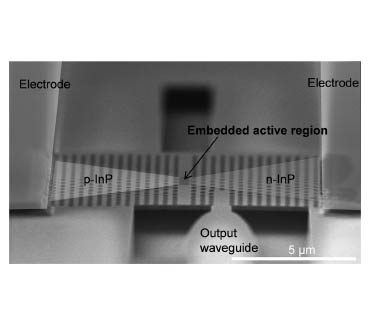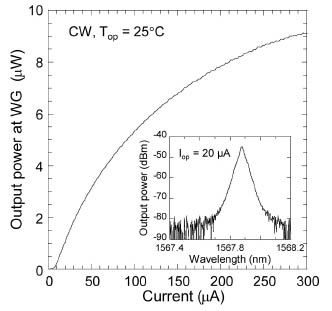1Nanophotonics Center, 2NTT Photonics Laboratories, 3Optical Science Laboratory
Photonic networks on CMOS chips have attracted a lot of attention as regards increasing transmission capacity, which is limited by the power consumption of electrical interconnects. The optical devices used for a photonic network on a CMOS chip are required to operate at an energy consumption of less than 10 fJ/bit. In this context, we have developed a photonic-crystal (PhC) nanocavity laser in which a small active region is embedded within an InP-based line defect waveguide. We call this a Lambda-scale Embedded Active-region PhC (LEAP) laser [1]. In this report, we report a LEAP laser with the lowest threshold current and energy consumption of any semiconductor laser operating at above room temperature, which we realized by reducing the leakage current.
Figure 1 shows a scanning electron microscope (SEM) image
of a LEAP laser. An ultra-small active region, which consists of an InGaAlAs
quantum-well structure, is embedded in a line defect in a 250 nm-thick
InP PhC slab. The volume is 0.12 µm3. To reduce the leakage current through the sacrificial layer and the substrate,
we change the sacrificial layer from InGaAs to InAlAs, because the bandgap
of an InAlAs layer is larger than those of InP and InGaAs layers. We fabricate
a lateral p-i-n junction by using Zn diffusion and Si ion implantation to inject carriers
into the active region.
Figure 2 shows the light versus current characteristic and the spectrum under continuous-wave (CW) operation at 25°C. The threshold current and the maximum output power of the output waveguide
were 7.8 µA and 9 µW, respectively. The lasing wavelength was
1567.8 nm at an injection current of 20 µA. We significantly reduced
the threshold current by using InAlAs for the sacrificial layer because
the threshold current of a LEAP laser with an InGaAs sacrificial layer
was 390 µA. In addition, 12.5-Gbit/s direct modulation was achieved
at an injection power of 174 µW and then the energy consumption was
estimated to be 14 fJ/bit. Furthermore, we achieved high temperature operation
up to 95°C with a LEAP laser [2].
This work was supported by NEDO.
[1] S. Matsuo et al., Optics Express 20 (2012) 3773.
[2] T. Sato et al., IEEE Photonics Conference (2012) WF-2.
 |
 |
|||||
|
|